
Until the COVID-19 pandemic, your healthcare newsletters were all about building community with your audience.
Suddenly, with the arrival of the coronavirus, your newsletter had to pivot to share crucial COVID-19 information: new safety procedures, rescheduling of nonemergency surgeries and where and how to get the vaccine.
A year and a half later, the Delta variant is putting our “back-to-normal” plans on hold. Your newsletters may be solely focused on communicating essential pandemic info.
But now’s the time to start working those community-building emails back into your newsletter rotation. These tips will rev up your newsletter and make your readers eager for more.
You love how your digital newsletters are great for saying “Hey there!” to your organization’s patients and families. They’re a relatively simple and inexpensive way to connect — to build trust among your current patients and develop relationships with prospective patients.
But how can you make sure your audience will say “Hey!” back? You’re competing for attention with a lot of other emails in their inbox.
If you want to develop a strong open rate (the percentage of recipients who open your newsletter after it lands in their email), you need to stand out from the digital crowd.
Ideally, your patient newsletter will:
But your newsletter won’t:
So what exactly makes for a good health newsletter? Check out these 5 tips — and 5 hospital websites where you can see them in action.
The best newsletters home in on a specialized group of patients and families. They don’t try to offer an information smorgasbord to your entire patient population.
Nationwide Children’s Hospital’s “Health E-Hints”
Columbus, Ohio
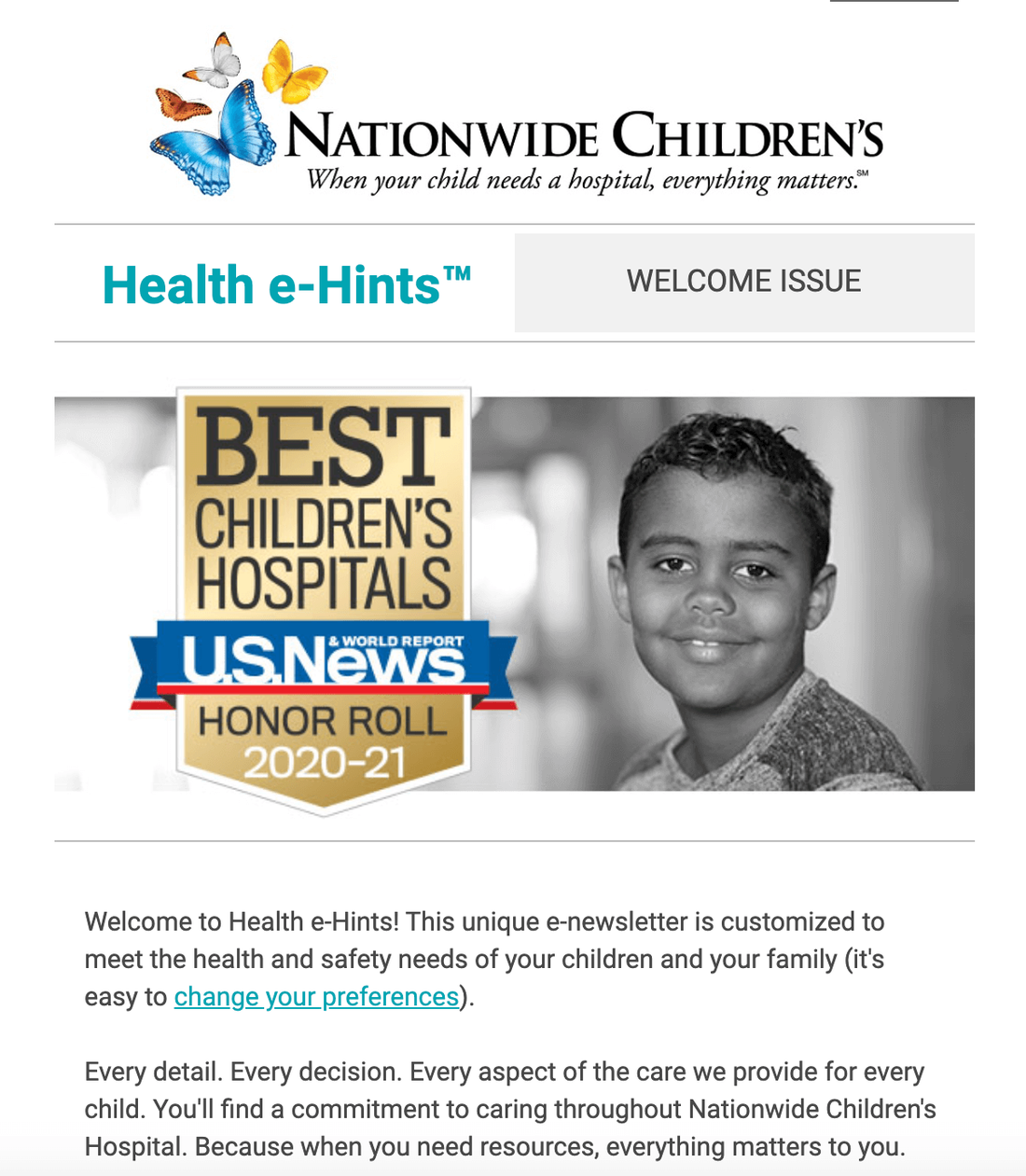
The parent of a toddler is interested in very different articles than the parent of a teen. Nationwide Children’s lets readers enter their children’s ages and customizes content for them. Then they automatically send age-appropriate newsletter articles to the subscribing parents as their children grow.
Want to include readers who aren’t parents? Nationwide lets subscribers identify themselves as child care providers or pediatricians and targets appropriate articles to them, too.
Patients and families who have “niche” health issues may have trouble finding trusted information from general consumer websites. Show potential and current patients that your organization’s experts are on top of the topics that matter to them. When these families need care, they may be more likely to turn to you.
University of California at Davis MIND Institute’s “Friends of the MIND”
Sacramento, California
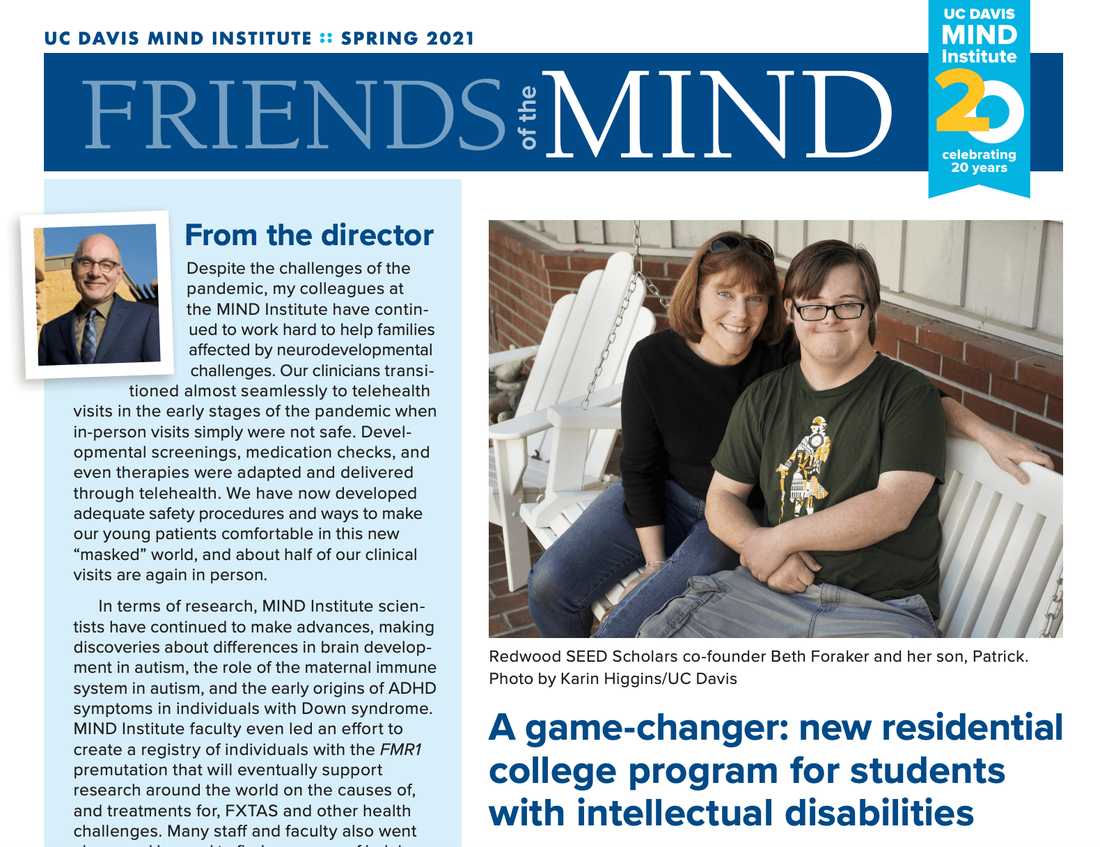
This quarterly print and digital newsletter shares patient stories as well as the latest research and treatment options for families who are facing neurodevelopmental challenges. These health issues include autism spectrum disorder, ADHD, fragile X syndrome and chromosome 22q11.2 deletion syndrome.
MIND Institute practitioners are prominently featured and/or interviewed in every article. This practice drives home to readers that UC Davis is a national leader in treating children and other family members with neurodevelopmental issues.
It’s good to get personal when creating patient newsletters. Readers connect with your organization more easily when you use friendly, second-person language — almost as if you’re writing a letter to someone you know.
Saint Luke’s Cardiovascular Associates “From the Heart”
Saint Luke’s Charles & Barbara Duboc Cardio Health & Wellness Center
Lee’s Summit, Missouri
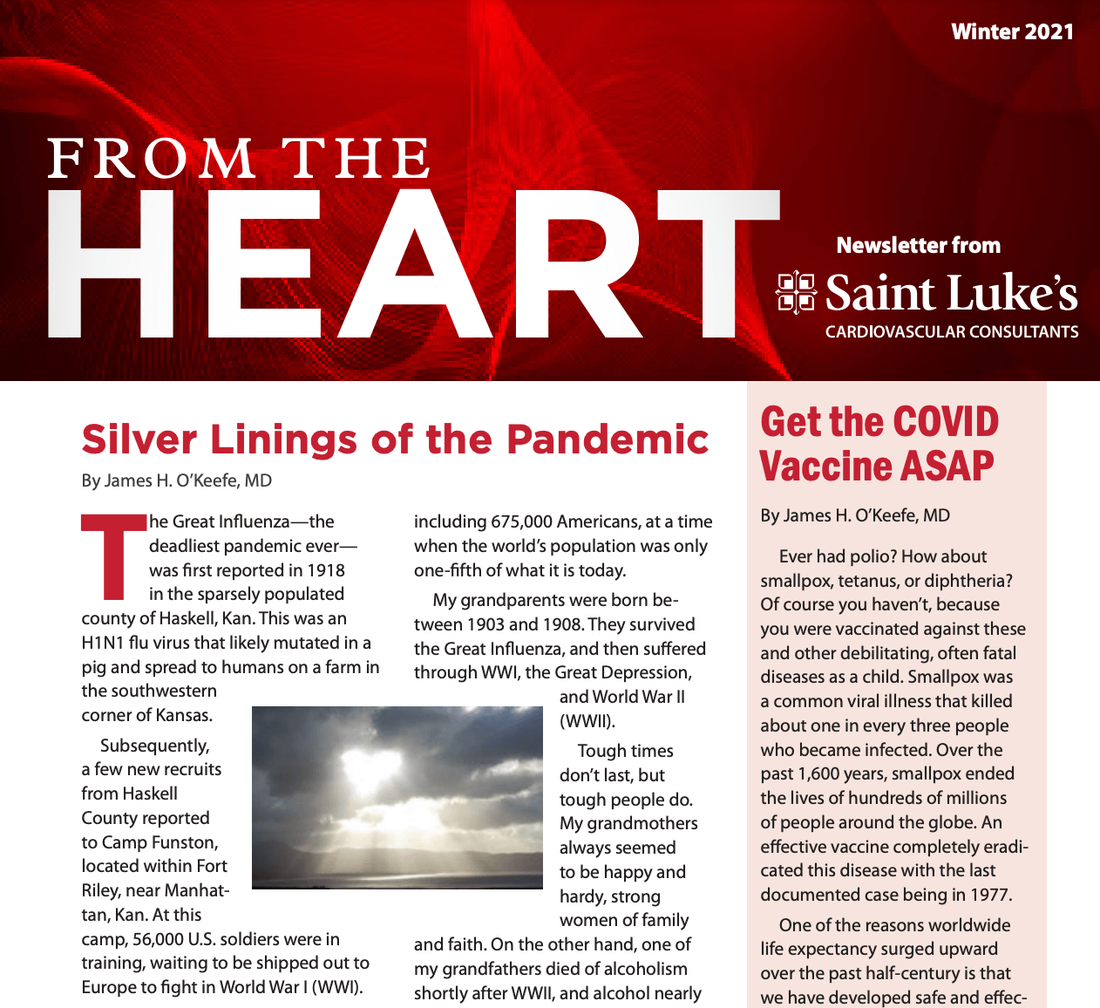
The title of this digital and print newsletter is clearly a nod to the subject matter (cardiovascular/heart issues). And it implies that articles will be personal, honest and compelling.
“From the Heart” includes patient success stories written in their own words, heart-healthy diet and lifestyle advice from Saint Luke’s experts and updates on new cardiovascular treatment options written in patient-centric language (e.g., “This very large and well-done study raised a lot of eyebrows among physicians and forced us to rethink how we dose blood pressure medicines.”)
Why reinvent the wheel? If you’re already creating strong online content, use quick synopses in your newsletters to invite readers to your blog. Patients and families who may not know about your blog may become regular visitors and improve your web statistics.
Seattle Children’s Hospital “my Good Growing”
Seattle, Washington
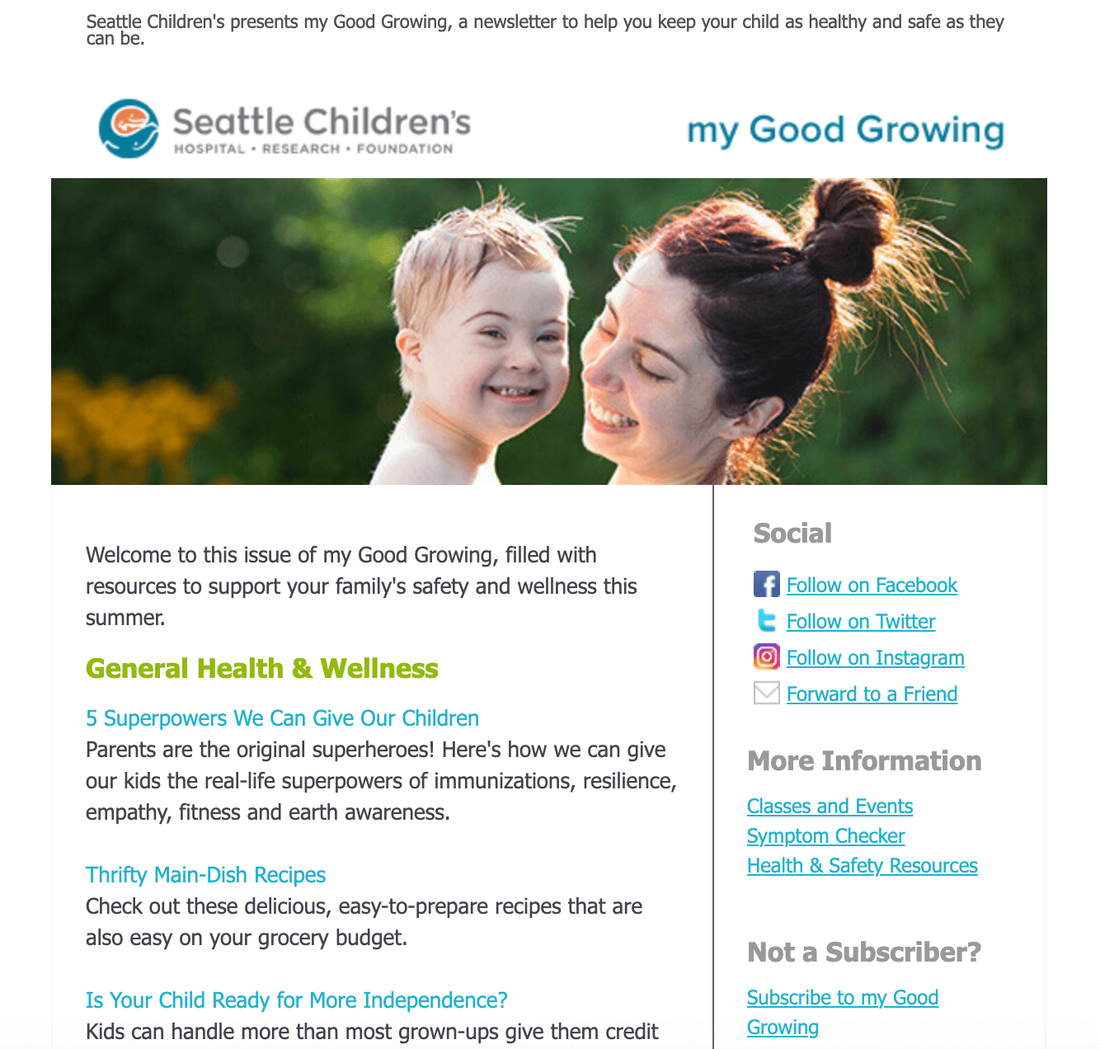
High-quality stock photos, easy-to-scan headlines and succinct article descriptions make it simple for time-pressured parents to pick and choose their topics. Seattle Children’s groups article descriptions clearly, both by topic and children’s ages.
When you follow links to the site’s “On the Pulse” blog, you land on professionally written articles featuring Seattle Children’s Hospital experts. Bullets, subheads and clearly labeled links make articles easy to read. A few selected links take readers to authoritative, outside sources such as the American Academy of Pediatrics.
Your readers, like everyone else, are leading busy lives, pulled in many different directions. But who doesn’t want to know about the health benefits of napping? Hook them with topics that pique their interest, answer a burning question or surprise them.
Cleveland Clinic, Health Essentials Blog
Cleveland, Ohio
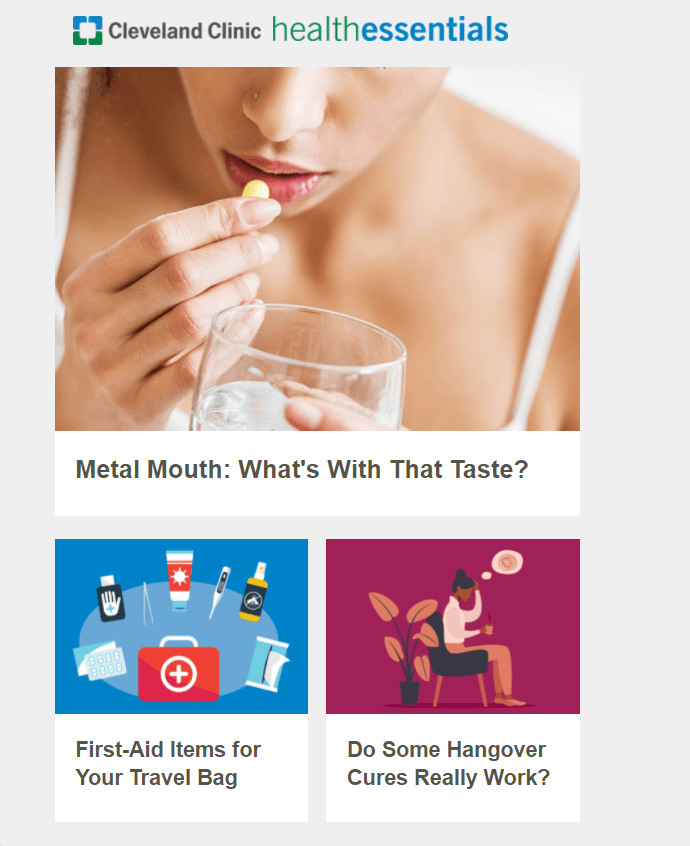
Cleveland Clinic’s newsletter includes helpful, timely content that interests a wide variety of readers — such as how to prevent and treat bee stings and a list of must-have first-aid items for your travel bag.
The blog posts all have a health angle as well as a general interest appeal. Besides links to popular blog posts, the newsletter often includes answers to engaging, health-related questions like, “Which hangover cures really work?” And every email includes a link to a nutritious recipe.
Make your newsletter the highlight of your audience’s inbox! These tips can help you turn a ho-hum newsletter into content that connects.
Explore more about writing for healthcare newsletters:
The original version of this page was published at: https://ahamediagroup.com/blog/2021/09/how-create-healthcare-newsletters-patients-read-5-tips/
We’re on a mission to deliver clear healthcare content to your readers. As a healthcare marketer, you are constantly detangling the complex web of content challenges. We can help by creating strat... Read more
Start with the endgame.That’s what I kept thinking as I prepped for our recent webinar on Rethinking Your Email Marketing for 2022. I had some great tips and strategies ...read more
Health content communicators and marketers: How can you raise your content level from “resonating with the audience” to “motivating them to take action?”You ...read more
You’ve successfully launched your hospital-branded app. Congrats!Now what?Now you gotta market it. Apps live in a separate universe from your other digital marketing properties. ...read more
What Did You Learn? Episode 7The coronavirus pandemic and Black Lives Matter movements shone a spotlight on a wide spectrum of brand responses: Some nailed it, while others dropped ...read more